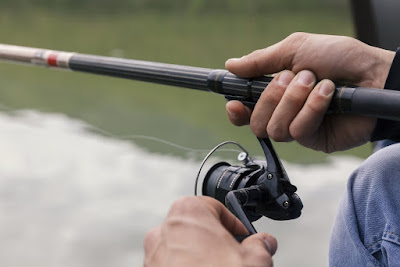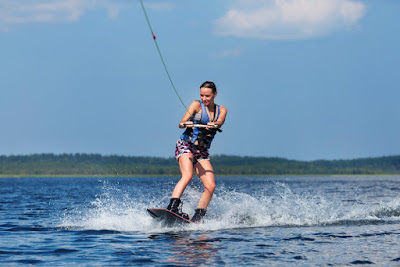Catch a BIG ONE at the Lake of the Ozarks! 🐟🐟
Some of the best family memories are made while fishing at the Lake of the Ozarks. While it may be colder this time of year, this is the best time to fish in this area because the cooler temperature can cause the bass to feed more heavily. Our boat club at the Lake of the Ozarks has some great boats to fish from. To learn more about becoming a member and having unlimited access to our Freedom Boat Club boats, visit our website at www.FreedomBoatClubLOTO.com. Keep reading to learn about 3 types of black bass that could be feeding heavily this time of year.
According to the Missouri Department of Conservation, there are 3 types of Black Bass:
Spotted Bass
Also called "spot" and "Kentucky bass," this species inhabits permanent-flowing waters that are warmer and slightly more turbid than those where the smallmouth bass occurs. Begin to recognize it by noting the form of its stripe and the length of its jaw.
Family: Centrarchidae (sunfishes) in the order Perciformes (perch-like fishes)
Description: Large, elongated fish with a large mouth. Upper jaw reaches to or slightly beyond the rear margin of the eye in adults. Green with a dark horizontal stripe. Upper parts are greenish with darker mottlings; the lower sides and belly are whitish with dark spots arranged in streaks. The midside has a broad, dark continuous stripe. Cheek scales much smaller than rest of body scales. The tongue has a rough patch.
Size: Total length: 10 to 17 inches; weight: 1/2 to 3 1/2 pounds; maximum about 20 inches and 4 to 5 pounds.
Largemouth Bass
Found in lowland lakes, artificial impoundments of all sizes, permanent pools of streams, and quiet backwaters of large rivers. Thrives in warm, moderately clear waters with little or no current.
Family: Centrarchidae (sunfishes) in the order Perciformes (perch-like fishes)
Description: The largemouth is a large, slender, elongated, streamlined sunfish with a very large mouth. The upper parts are greenish; the lower sides and belly are white, without dark spots or with spots that are irregularly arranged. The midside has a broad, dark, continuous stripe. The upper jaw reaches far beyond the rear margin of the eye, except in small young. The tongue is smooth. The dorsal fins not well connected. The cheek scales are the same size as the rest of the body scales.
Size: Total length: 10 to 20 inches; weight: ½ to 4½ pounds; maximum about 24 inches and 15 pounds.
Smallmouth Bass
Also called "brown bass," "brownie" and "bronzeback," this popular gamefish is found predominantly in cool, clear Ozark streams and large reservoirs in the Ozarks. Found sparingly in the upper Mississippi River and it's principal prairie tributaries that have clear water and permanent flow.
Family: Centrarchidae (sunfishes) in the order Perciformes (perch-like fishes)
Description: Large, elongated fish with a moderately large mouth. Cheek scales are much smaller than the rest of body scales. The back and sides are greenish-brown with faint dark mottling and bars; the belly is whitish overlain with dusky pigment. No dark horizontal stripe. Without rows of dark spots. Upper jaw reaches to about the rear margin of the eye in adults. Tongue usually has a rough patch. Dorsal fins connected. Most closely related to largemouth and spotted bass.
Size: Total length: 10 to 20 inches; weight 1/2 to 4 pounds; maximum about 22 inches long and 6 pounds.
To sign up for one of our fantastic boat club memberships at the Lake of the Ozarks, call us today. We can be reached at 573-302-0392. Welcome aboard!
According to the Missouri Department of Conservation, there are 3 types of Black Bass:
Spotted Bass
Also called "spot" and "Kentucky bass," this species inhabits permanent-flowing waters that are warmer and slightly more turbid than those where the smallmouth bass occurs. Begin to recognize it by noting the form of its stripe and the length of its jaw.
Family: Centrarchidae (sunfishes) in the order Perciformes (perch-like fishes)
Description: Large, elongated fish with a large mouth. Upper jaw reaches to or slightly beyond the rear margin of the eye in adults. Green with a dark horizontal stripe. Upper parts are greenish with darker mottlings; the lower sides and belly are whitish with dark spots arranged in streaks. The midside has a broad, dark continuous stripe. Cheek scales much smaller than rest of body scales. The tongue has a rough patch.
Size: Total length: 10 to 17 inches; weight: 1/2 to 3 1/2 pounds; maximum about 20 inches and 4 to 5 pounds.
Largemouth Bass
Found in lowland lakes, artificial impoundments of all sizes, permanent pools of streams, and quiet backwaters of large rivers. Thrives in warm, moderately clear waters with little or no current.
Family: Centrarchidae (sunfishes) in the order Perciformes (perch-like fishes)
Description: The largemouth is a large, slender, elongated, streamlined sunfish with a very large mouth. The upper parts are greenish; the lower sides and belly are white, without dark spots or with spots that are irregularly arranged. The midside has a broad, dark, continuous stripe. The upper jaw reaches far beyond the rear margin of the eye, except in small young. The tongue is smooth. The dorsal fins not well connected. The cheek scales are the same size as the rest of the body scales.
Size: Total length: 10 to 20 inches; weight: ½ to 4½ pounds; maximum about 24 inches and 15 pounds.
Smallmouth Bass
Also called "brown bass," "brownie" and "bronzeback," this popular gamefish is found predominantly in cool, clear Ozark streams and large reservoirs in the Ozarks. Found sparingly in the upper Mississippi River and it's principal prairie tributaries that have clear water and permanent flow.
Family: Centrarchidae (sunfishes) in the order Perciformes (perch-like fishes)
Description: Large, elongated fish with a moderately large mouth. Cheek scales are much smaller than the rest of body scales. The back and sides are greenish-brown with faint dark mottling and bars; the belly is whitish overlain with dusky pigment. No dark horizontal stripe. Without rows of dark spots. Upper jaw reaches to about the rear margin of the eye in adults. Tongue usually has a rough patch. Dorsal fins connected. Most closely related to largemouth and spotted bass.
Size: Total length: 10 to 20 inches; weight 1/2 to 4 pounds; maximum about 22 inches long and 6 pounds.
Fish with Freedom Boat Club!
To sign up for one of our fantastic boat club memberships at the Lake of the Ozarks, call us today. We can be reached at 573-302-0392. Welcome aboard!
We Do All The Work. You Have All The Fun.
873 Crow Ln. Ste. B5
Osage Beach, MO 65065
573-302-0392
Bridgeview Marina 19MM
NEW 2nd Location
1062 Susan Rd.
Lake Ozark, MO 65049
Osage Villa Resort 2MM
jimkoch@freedomboatclub.com







Comments
Post a Comment